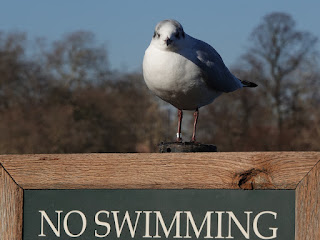A most unusual Great Spotted Woodpecker appeared on the Parade Ground. It had the mutation helpfully called 'Brown' in which the black parts fade to brown because little black eumelanin pigment is produced. There are two kinds of melanin: the other, phaeomelanin, is red. The result is this colour.
A Redwing perched in the next tree. There's plenty of phaeomelanin here in the stripes under its wings ...
... and even more in the face of a Goldfinch in the treetop ...
... and the red breast of a Robin in the Flower Walk.
Most Wrens are very shy and flee if you look at them, but sometimes they learn that people won't harm them. This one in the Flower Walk has reached the stage where it will hop around almost at your feet.
A Starling at the Dell restaurant shone brilliantly in the sunshine.
Volunteers have been cutting down the reeds at the Diana fountain. Ideally you should do this every second winter to ensure that they grow up thickly, and certainly they had been getting very straggly and needed a trim. A Carrion Crow looked for insects in the stubble.
The pigeon-eating Lesser Black-Backed Gull was at the Dell restaurant with his mate -- he is at the front here. Both now have the smart pure white heads of their breeding plumage.
The Black-Headed Gull EZ73323 had just knocked a rival off his post and was looking pleased with himself.
The dominant gull on the landing stage glared at a passing Mute Swan.
A Great Crested Grebe kept a respectful distance, knowing that if it came too close the gull would attack it.
The Little Grebe in the Italian Garden was diving by itself, as the companion Mallards were dozing in a clump of irises.
A Moorhen poked about under a fountain.
Strange goings-on under a tree in the Flower Walk, where a squirrel was frantically chewing a twig and rolling around. Another squirrel was there, but I really don't know whether this was some kind of mating ritual or the creature was just feeling the joy of approaching spring.
A pair of squirrels near the Speke obelisk had probably been mating, and were now relaxing in a comfortable heap enjoying the sunshine.
A cat was being taken for a walk on a lead. It seemed quite used to this arrangement, and was wandering around sniffing at things. It had a rest on the terrace of the Dell restaurant and looked longingly at some Coots just out of reach in the water.
Ahmet Amerikali was at Southwark Park, where he saw the Firecrest again.






%20and%20mate%202023%201a.jpg)






%202023%202a.jpg)
I've never seen a squirrel behave like that. Wonder if there's anything to the urban myth of them ingesting discarded drugs.
ReplyDeleteThat sounds dreadfully likely.
DeleteThanks for sharing the photo of the aberrant Great Spotted Woodpecker-have never seen one of these before.
ReplyDeleteI suppose the Brown mutation can happen to any bird with melanin in its feathers. I've seen a Brown Carrion Crow, and it's common in Mallards and Feral Pigeons.
DeleteI had a replica of that brown mutation woodpecker on my feeders earlier. Very striking bird.
DeleteI live a couple of miles west of Heathrow.
Remarkable. Much too far apart for them to be siblings. That was the first brown GSW I have ever seen. Even Tom hadn't seen one.
DeleteWhat a lovely symphony in red! The brown mutation bird is awfully pretty.
ReplyDeleteIs that a British Shorthair? I'm not very good at cats.
Nothing as spectacular, but I have seen birds get punch drunk and do very funny things when eating arbutus.
Tinúviel
The red parts of the woodpecker look redder than usual too. I haven't heightened the colour of that photograph.
DeleteConsidering the number of exotic plants in the park, I wouldn't be surprised if the squirrel had chewed some shrub that intoxicated it. I suppose that overripe arbutus fruits, which are sugary, ferment spontaneously and become alcoholic. But it's too late in the winter for any of those to be around.